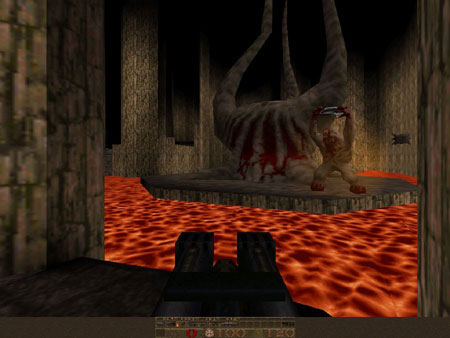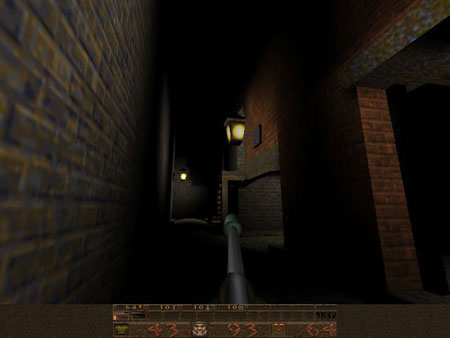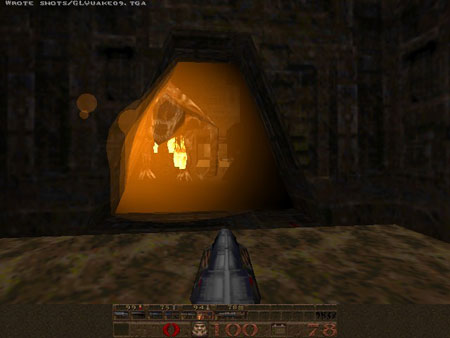With no fewer than three OS X versions available, id Software’s best-selling game Quake may be old by computer game standards (the original PC version was released in 1996, and the Mac version a year later), but it is far from being retired. At its simplest, Quake is a first-person virtual reality action game, where the player takes on the role of a lone marine fighting the forces of evil by basically killing anything that moves. So far, so similar to id Software’s previous foray into the genre, Doom, released in 1993. But what makes Quake different is that the player finds himself in a three dimensional environment where light, shadow and sound all work together to create a rich, if violent and hazardous, world. Heightening this effect is the music that accompanied the game composed by Trent Reznor and performed by Nine Inch Nails: by turns gothic and industrial, but always dark and brooding. For those with an eye to design, the style of the interface and the packaging of the game are equally compelling. The box looks weathered and the logo corroded, there’s an imaginative use of fonts and feedback sounds that give the program a very menacing feel, building up the sense of foreboding even before you meet your first monster.
 |
|
The final battle in the original Quake game, your meeting with Shub-Niggurath and her servants, including the lightning wielding shambler.
|
Quake delves hungrily into various dark fantasy sources, most especially the works of H P Lovecraft (US; 1890-1937) who is probably the best-known exponent of the cosmic horror literary genre. Lovecraft imagined mankind to be but the latest in a succession of inhabitants on this Earth, and that our predecessors here were incomprehensibly more ancient and far more powerful than we could imagine. Worse still, these powerful beings will return and displace us, favouring only those few who worship them now and relegating the rest to destruction or slavery. Seen in this light the ancient religions seem much more disturbing and dangerous, and that was precisely his hook into our fear of the darkness. Lovecraft’s fiction works so powerfully because it plays on our suspicions that the builders of Stonehenge and the Easter Island statues knew something we did not; that untranslatable inscriptions and fragmentary texts in our museums are not nearly as benign as the historians assure us; and that the picturesque incantations of latter-day witches are not entirely harmless. Quake includes some quite obvious transferrals from Lovecraft’s world, such as Shub-Niggurath herself and the names of various levels like “The Vaults of Zin” and “The Elder God Shrine”. But there are also more subtle things, signs of blood sacrifice and tortured souls, flayed skin stretched over lights and crucifixions, enough to make even the hardened gamer take pause. Clearly, the world of Quake was not one where humans were the masters, a world in which there was either bloody violence or extinction. For some, Quake as not just violent but satanic.
Fun as it was as a single player game, Quake was also among the first multiplayer games to really catch on, particularly in the office environment where Ethernet networks provided a means for “frag-fests”, a chance for co-workers to use shotguns and grenade launchers on one another. (In Quake parlance, someone who’s been killed is “fragged” and if blown into little bloody pieces, as can happen in the game, they’re not just fragged but “gibbed” as well.)
Maps, Modifications and Total Conversions
For all the grittiness and quality of the original, this is still an eight-year old game, and there have been a succession of games with more realistic visual effects and challenging play, not least of all new versions of Quake itself, as well as games like Unreal and most recently Return to Castle Wolfenstein. So why does the original Quake come under the heading of a “classic”, and moreover, why people producing OS X versions of the game? The answer lies in its replayability: maps, modifications and total conversions can be downloaded from the Internet or purchased as expansion packs and provide the Quake player with a whole new game.
Maps are freestanding levels that can be produced relatively easily using shareware packages such as Quark and Quest. Although most Quake mappers seem to use Windows programs, there is a Mac one out there, Quiver, and a freeware Java-based program JQT. These tools are all more or less similar to drawing packages, allowing the user to draw the layout of the map, insert useful objects like ammunition, and then populate the level with Quake monsters. Having made it sound rather easy, it has to be said that imaginative, challenging maps are difficult to do, and the best mappers clearly work very hard getting the balance between eye-candy, difficulty, and performance just right. Mappers like Ikka Keranen, Neil Manke and Pete Burrows are among those whose work most impresses me, at least.
 |
|
Pete Burrows’ exceptionally atmospheric map “From Hell” sends the player on the trail of Jack the Ripper, complete with gas-lit alleys, corpses and scrawled messages. Not for the faint-hearted!
|
A step up from single maps are modifications, which as their name suggests change the Quake game in some way beyond simply providing a new map to explore. Some modifications change the weapons used, augmenting the original line-up with things like chainsaws and flamethrowers. Xoron’s Weapons Patch is one such example of this type of thing. Other modifications are more ambitious, changing the monsters and weapons as well as the scenery and the sounds. These are called total conversions, and one of the most notorious of these was the Alien Quake TC project, which was killed off in 1997 by the holders of the Alien franchise copyright, Twentieth Century Fox. Those lucky enough to have downloaded and enjoyed this conversion before its death got to kill face-huggers and alien drones that were re-workings of the original Quake monsters. A remarkable total conversion put together by amateurs is Zerstorer. Among the commercial total conversions, Malice stands out from the crowd with inspired new toys such as submarines to explore underwater maps with and frightening new monsters. It even has a plot, little movies that link up each episode explaining what’s going on, and a rather good techno-industrial soundtrack.
 |
|
Though it didn’t amuse the lawyers at Twentieth Century Fox, the Alien Quake total conversion was rather fun, if a lot less polished than the official Aliens versus Predator game.
|
Websites like the Retro Quake specialise in reviewing classic Quake maps, as well as the new maps that do still seem to be being cranked out. Although designed for the most part on PCs, with a very few exceptions these maps, modifications and total conversions work with Mac versions of the Quake game just fine. The trick is in the use of the “console”, by default brought down in the Quake game by pressing the tilde key. Typing in “map map01” and then hitting return will load up a map called “map01” from the map folder within the Quake directory, for example. Loading up modifications and total conversions is a little more complex, but instructions normally come with them make this exercise simple enough to do.
Quake Resurrection
Expandability is certainly one reason why Quake has my vote as one of the best-value and most consistently entertaining games out there, but another good reason to go back to it now are the various OS X incarnations of the game to be downloaded and enjoyed. None of these are free-standing games, you’ll need the original Quake for all the maps and monsters, these are simply replacements for the original Classic version of the application. But you don’t need the Mac version of Quake to use them, the PC version works fine, though obviously you won’t have the installer to copy the files to the Application folder and will need to do this by hand.
Fruitz of Dojo is one supplier, with a stylish website almost worth the visit in itself. Two versions of their OS X Quake application exist, a basic version for mere mortal computers, and a TenebraeQuake for those with serious computing power and a rocking graphics card. GLQuake offers an alternative OS X application with a slightly different interface. All these Quake applications work well, although performance can vary depending on the computer, and in some cases modifications and total conversions that work with one application don’t seem to work with another. It’s a good idea to download all three and see which works best for you.
Besides the advantages of being OS X compatible, these new versions of Quake let you enjoy things that just weren’t possible when Quake first came out: big 1024 by 768 pixel screen, better fire and lighting effects, translucent water and so on. TenebraeQuake especially pushes this further than ever before and doesn’t just need an OS X machine but a very powerful one at that.
Conclusion
Quake remains a classic. It is OS X compatible, but will work well on anything from an iBook to a G5, and if you have a connection to the Internet you can easily download hundreds of hours worth of gaming in the form of maps and modifications. The gameplay is right up there with the best modern shoot ’em ups, and with the processing power of even a modest OS X compatible computer you can afford to have full screen resolution with all the eye candy turned on. Although the CD-ROM is required for the music, you can leave it out if you just want to play the game, making it a great timewaster for PowerBook owners looking for something to while away the hours on the train or plane. All in all, Quake offers some of the most bang for your buck out there and should be on the shelf of every serious Mac gamer.
-
Product: Quake
-
OS X: No
-
Classic: Yes
-
Publisher: id Software
-
Category: Game
-
Price: At Amazon, under $5
-
Requirements: Power Macintosh, System 7.6, CD drive, 16 MB RAM
-
Product: Quake v. 1.0.9 and TenebraeQuake v. 1.0.9
-
OS X: Yes
-
Classic: No
-
Publisher: Fruitz of Dojo
-
Category: Game updater
-
Price: Freeware
-
Requirements: Power Macintosh G3 or G4, OS X; TenebraeQuake additionally requires OS X 10.2.3 and an ATI Radeon or NVIDIA graphics card
-
Product: GLQuake
-
OS X: Yes
-
Classic: Yes
-
Publisher: Open Source
-
Category: Game updater
-
Price: Freeware
-
Requirements: Power Macintosh G3 or G4, OpenGL-compatible graphics card with 4 MB VRAM or better

Leave a Reply
You must be logged in to post a comment.